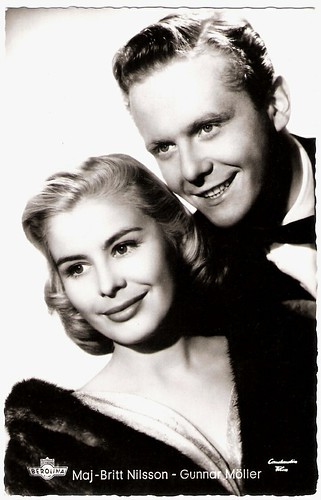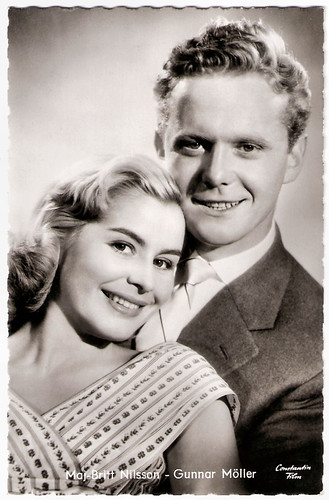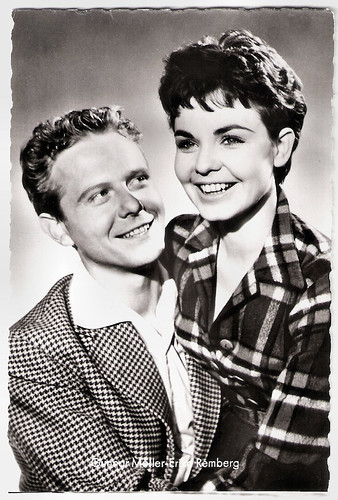German actor Gunnar Möller (1928-2017) was one of the stars of the Wirtschaftswunder Kino of the 1950s. He appeared in over 160 film and television productions between 1940 and 2016. He later turned to character roles and worked for a number of years in England.
![Gunnar Möller]()
German postcard by Film-Foto-Verlag, Berlin-Tempelhof, no. FK 244. Photo: Veit / Gloria Film. Publicity still for Ferien vom Ich/Holiday From Myself (Hans Deppe, 1952).
![Gunnar Möller in Ehe für eine Nacht (1953)]()
German postcard by Kunst und Bild, Berlin, no. A 743. Photo: Ariston / Neue Filmverleih (NF). Publicity still for Ehe für eine Nacht/Marriage for One Night (Viktor Tourjansky, 1953).
![Gunnar Möller]()
German postcard by Kunst und Bild, Berlin, no. A 1210. Photo: Europa / Bristol-Mundus Film. Publicity still for Ein Haus voll Liebe/A house full of love (Hans Schweikart, 1954).
Gunnar Thor Karl Möller was born in 1928 in Berlin, Germany. He was the son of a master optician.
As a child, Gunnar already took part in some 20 films during World War II. After the war, he had a stage education. The theatre offered him his first engagements, and he worked successfully on the stages of Berlin and later Munich with Gustaf Gründgens and other stage directors.
Then he again gained a foothold in the film business with a role as a student in Wozzeck (Georg C. Klaren, 1947). He followed this up with parts in Heimliches Rendezvous/Secret Rendezvous (Kurt Hoffmann, 1949) with Hertha Feiler, and Hans im Glück/Lucky Hans (Peter Hamel, 1949) with Erich Ponto.
In the 1950s followed the height of Gunnar Möller's career with roles in many popular productions. He was especially successful with his role in the romantic comedy Ich denke oft an Piroschka/I Often Think of Piroschka (Kurt Hoffmann, 1955) with Liselotte Pulver.
Later he became a character actor such as in the war film Hunde, wollt ihr ewig leben/Stalingrad: Dogs, Do You Want to Live Forever? (Frank Wisbar, 1959), starring Joachim Hansen, and the British thriller SOS Pacific (Guy Green, 1959), with Richard Attenborough and Pier Angeli.
![Maj-Britt Nilsson and Gunnar Möller in Was die Schwalbe sang]()
German postcard by Kolibri-Verlag, Minden/Westf., no. 2247. Photo: Berolina / Constantin / Wesel. Publicity still for Was die Schwalbe sang/What the swallow sang (Géza von Bolvary, 1956) with Maj-Britt Nilsson.
![Maj-Britt Nilsson and Gunnar Möller in Was die Schwalbe sang (1956)]()
German postcard by Kolibri-Verlag, Minden/Westf. Photo: Constantin Film / Wesel. Publicity still for Was die Schwalbe sang/What the swallow sang (Géza von Bolvary, 1956) with Maj-Britt Nilsson.
![Gunnar Möller and Erika Remberg]()
German postcard by Kolibri-Verlag G.m.b.H., Minden-Westf., no. 2838. Photo: publicity still for Drei weiße Birken/Three white birches (Hans Albin, 1961) with Erika Remberg.
Gunnar Möller's popularity decreased in the 1960s. One of his more interesting films was Liselotte von der Pfalz (Kurt Hoffmann, 1966) featuring Heidelinde Weis.
From then on his activities varied between theatre, cinema and TV. His later films included the Czech war drama Dny zrady/Days of Betrayal (Otakar Vávra, 1973) in which he played Adolf Hitler, the British thriller The Odessa File (Ronald Neame, 1974), and another Czech war drama Osvobození Prahy (Otakar Vávra, 1978).
In 1979 a tragic incident happened when Möller killed his wife, the actress Brigitte Rau, with a stool during a divorce argument in London. He was sentenced to five years in prison in England because of second-degree murder. He served two years and was released on probation in 1981.
He was able to continue his career in Germany and played in the films Im Zeichen des Kreuzes/The Sign of the Cross (Rainer Boldt, 1983), and the crime film Die Nacht der vier Monde/Night of the Four Moons (Jörg A. Eggers, 1984).
Most often he worked in the theatre. His final film appearance was a small part in the Italian/French thriller Le confessioni/The Confessions (Roberto Andò, 2016) with Toni Servillo and Daniel Auteuil.
Gunnar Möller was married from 1954 till her death in 1979 to Brigitte Rau and from 2003 till his death to actress Christiane Hammacher, with whom he had performed in Loriots Dramatische Werke (Loriot's Dramatic Works) at Frankfurt's Fritz Rémond Theater and on tour during the 1980s.
Möller died in 2017 in his hometown Berlin. He had three children from his marriage with Brigitte Rau: Michael, Florian and Hillevi.
![Gunnar Möller]()
German postcard by Rüdel-Verlag. Photo: Georg Witt / Schorchtfilm. Publicity still for Ich denke oft an Piroschka/I Often Think of Piroschka (Kurt Hoffmann, 1955).
![Gunnar Möller in Was die Schwalbe sang (1956)]()
German postcard by Ufa/Film-Foto, Berlin-Tempelhof, no. HK 3272. Photo: Wesel / Berolina / Constantin Film. Publicity still for Was die Schwalbe sang/What the swallow sang (Géza von Bolváry, 1956).
![Gunnar Möller in Was die Schwalbe sang (1956)]()
German postcard by Kunst und Bild, Berlin, no. V 104. Photo: Constantin Film / Berolina / Wesel. Publicity still for Was die Schwalbe sang/What the swallow sang (Géza von Bolváry, 1956).
![Gunnar Möller]()
German autograph card by Simon offset, München. Photo: Virginia.
Sources: Wikipedia and IMDb.

German postcard by Film-Foto-Verlag, Berlin-Tempelhof, no. FK 244. Photo: Veit / Gloria Film. Publicity still for Ferien vom Ich/Holiday From Myself (Hans Deppe, 1952).

German postcard by Kunst und Bild, Berlin, no. A 743. Photo: Ariston / Neue Filmverleih (NF). Publicity still for Ehe für eine Nacht/Marriage for One Night (Viktor Tourjansky, 1953).

German postcard by Kunst und Bild, Berlin, no. A 1210. Photo: Europa / Bristol-Mundus Film. Publicity still for Ein Haus voll Liebe/A house full of love (Hans Schweikart, 1954).
A foothold in the film business
Gunnar Thor Karl Möller was born in 1928 in Berlin, Germany. He was the son of a master optician.
As a child, Gunnar already took part in some 20 films during World War II. After the war, he had a stage education. The theatre offered him his first engagements, and he worked successfully on the stages of Berlin and later Munich with Gustaf Gründgens and other stage directors.
Then he again gained a foothold in the film business with a role as a student in Wozzeck (Georg C. Klaren, 1947). He followed this up with parts in Heimliches Rendezvous/Secret Rendezvous (Kurt Hoffmann, 1949) with Hertha Feiler, and Hans im Glück/Lucky Hans (Peter Hamel, 1949) with Erich Ponto.
In the 1950s followed the height of Gunnar Möller's career with roles in many popular productions. He was especially successful with his role in the romantic comedy Ich denke oft an Piroschka/I Often Think of Piroschka (Kurt Hoffmann, 1955) with Liselotte Pulver.
Later he became a character actor such as in the war film Hunde, wollt ihr ewig leben/Stalingrad: Dogs, Do You Want to Live Forever? (Frank Wisbar, 1959), starring Joachim Hansen, and the British thriller SOS Pacific (Guy Green, 1959), with Richard Attenborough and Pier Angeli.

German postcard by Kolibri-Verlag, Minden/Westf., no. 2247. Photo: Berolina / Constantin / Wesel. Publicity still for Was die Schwalbe sang/What the swallow sang (Géza von Bolvary, 1956) with Maj-Britt Nilsson.

German postcard by Kolibri-Verlag, Minden/Westf. Photo: Constantin Film / Wesel. Publicity still for Was die Schwalbe sang/What the swallow sang (Géza von Bolvary, 1956) with Maj-Britt Nilsson.

German postcard by Kolibri-Verlag G.m.b.H., Minden-Westf., no. 2838. Photo: publicity still for Drei weiße Birken/Three white birches (Hans Albin, 1961) with Erika Remberg.
Second-degree murder
Gunnar Möller's popularity decreased in the 1960s. One of his more interesting films was Liselotte von der Pfalz (Kurt Hoffmann, 1966) featuring Heidelinde Weis.
From then on his activities varied between theatre, cinema and TV. His later films included the Czech war drama Dny zrady/Days of Betrayal (Otakar Vávra, 1973) in which he played Adolf Hitler, the British thriller The Odessa File (Ronald Neame, 1974), and another Czech war drama Osvobození Prahy (Otakar Vávra, 1978).
In 1979 a tragic incident happened when Möller killed his wife, the actress Brigitte Rau, with a stool during a divorce argument in London. He was sentenced to five years in prison in England because of second-degree murder. He served two years and was released on probation in 1981.
He was able to continue his career in Germany and played in the films Im Zeichen des Kreuzes/The Sign of the Cross (Rainer Boldt, 1983), and the crime film Die Nacht der vier Monde/Night of the Four Moons (Jörg A. Eggers, 1984).
Most often he worked in the theatre. His final film appearance was a small part in the Italian/French thriller Le confessioni/The Confessions (Roberto Andò, 2016) with Toni Servillo and Daniel Auteuil.
Gunnar Möller was married from 1954 till her death in 1979 to Brigitte Rau and from 2003 till his death to actress Christiane Hammacher, with whom he had performed in Loriots Dramatische Werke (Loriot's Dramatic Works) at Frankfurt's Fritz Rémond Theater and on tour during the 1980s.
Möller died in 2017 in his hometown Berlin. He had three children from his marriage with Brigitte Rau: Michael, Florian and Hillevi.

German postcard by Rüdel-Verlag. Photo: Georg Witt / Schorchtfilm. Publicity still for Ich denke oft an Piroschka/I Often Think of Piroschka (Kurt Hoffmann, 1955).

German postcard by Ufa/Film-Foto, Berlin-Tempelhof, no. HK 3272. Photo: Wesel / Berolina / Constantin Film. Publicity still for Was die Schwalbe sang/What the swallow sang (Géza von Bolváry, 1956).

German postcard by Kunst und Bild, Berlin, no. V 104. Photo: Constantin Film / Berolina / Wesel. Publicity still for Was die Schwalbe sang/What the swallow sang (Géza von Bolváry, 1956).

German autograph card by Simon offset, München. Photo: Virginia.
Sources: Wikipedia and IMDb.